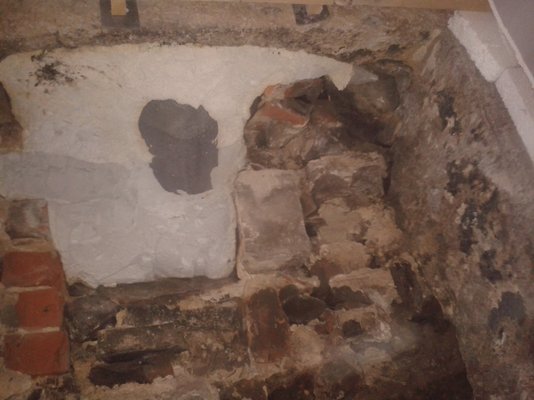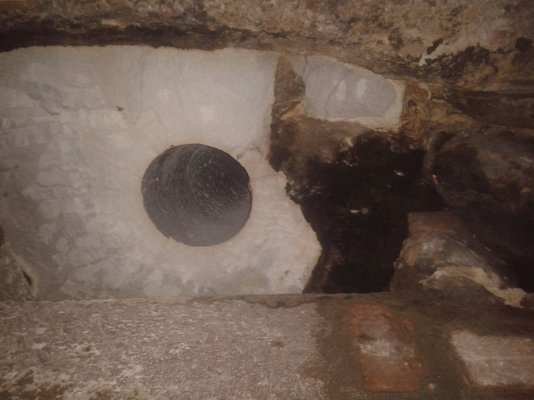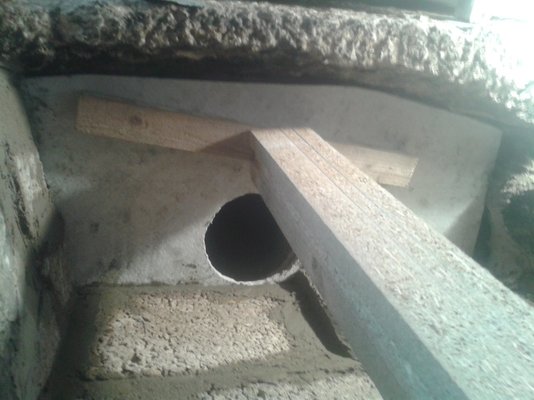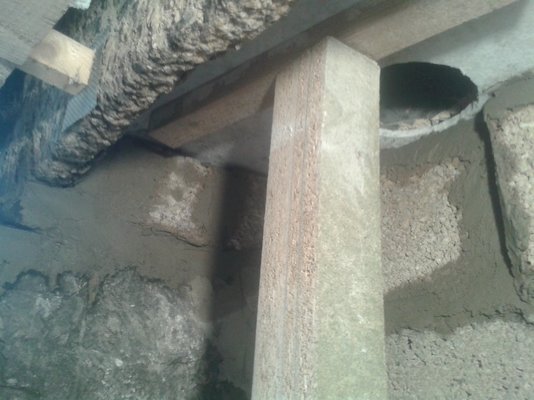You are using an out of date browser. It may not display this or other websites correctly.
You should upgrade or use an alternative browser.
You should upgrade or use an alternative browser.
Wood stove
- Thread starter rosinante
- Start date
julianf
Member
- Messages
- 8,835
- Location
- devon, uk
rosinante
Member
- Messages
- 1,345
- Location
- Cornwall England
Hi Julian , thank you for your reply , I was just about to set off to buy a stove to fit in my fireplace , not going now, have had a look a doc J but can't find the bit you are referring to , could you tell me where it is in the document please , I want to read up so when go to buy a stove Iam armed with a little knowedge , yes I am aware it's dangerous , but it may hep , thanks again
Chris
Chris
julianf
Member
- Messages
- 8,835
- Location
- devon, uk
Diagram 30, page 42.
The diagram itself doesn't mention clearance above, but the second half of the table below the diagram lists the height above the appliance to non combustible material.
If you have a wooden beam above, then it all becomes more troubled, as you probably wont have the clearance from the flue itself either. This can be gotten around by using twin wall insulated flue, which lowers the clearance to, IIRC, 50mm. But, again, this is flue stuff, not height above appliance (and it was height above appliance that you were asking about, and that is detailed on pg 42)
The diagram itself doesn't mention clearance above, but the second half of the table below the diagram lists the height above the appliance to non combustible material.
If you have a wooden beam above, then it all becomes more troubled, as you probably wont have the clearance from the flue itself either. This can be gotten around by using twin wall insulated flue, which lowers the clearance to, IIRC, 50mm. But, again, this is flue stuff, not height above appliance (and it was height above appliance that you were asking about, and that is detailed on pg 42)
waddycall
Member
- Messages
- 1,967
I think you’re misreading the table on pg42. It states the minimum thickness of non combustible materials at certain distances from the appliance not the required clearances. For clearances you need to comply with the stove manufacturers instructions and they should have done a temperature safety test to determine minimum distance to combustible material although when I was in the stove designing business EN13240 didn’t require temperatures above the stove to be measured. We did it anyway when we could.Diagram 30, page 42.
The diagram itself doesn't mention clearance above, but the second half of the table below the diagram lists the height above the appliance to non combustible material.
If you have a wooden beam above, then it all becomes more troubled, as you probably wont have the clearance from the flue itself either. This can be gotten around by using twin wall insulated flue, which lowers the clearance to, IIRC, 50mm. But, again, this is flue stuff, not height above appliance (and it was height above appliance that you were asking about, and that is detailed on pg 42)
I would suggest getting the flue swept before fitting any appliances, even if you are going to get a new flue lining. Chimney sweeps are not too dear and they will be qualified to inspect your flue (ooer mrs) & tell you exactly what you need and what you can or can't do.
julianf
Member
- Messages
- 8,835
- Location
- devon, uk
I think you’re misreading the table on pg42. It states the minimum thickness of non combustible materials at certain distances from the appliance not the required clearances. For clearances you need to comply with the stove manufacturers instructions and they should have done a temperature safety test to determine minimum distance to combustible material although when I was in the stove designing business EN13240 didn’t require temperatures above the stove to be measured. We did it anyway when we could.
I think, more likely, we are both wrong, now that I've looked at the table again.
Its not exactly minimum thicknesses of materials, as figures like 1200mm are mentioned and 300mm...
I think that, what its saying is that you need to bring non combustibles up to a height of 1200 above the hearth surface, and to at least 300mm above the appliance.
Im sure its in the document somewhere though - it has the clearance at the sides of the appliance, and to the rear of the appliance (not that i can find either right now) so you would imagine it would have the clearence above the appliance also.
But, yes, you are entirely right - i think i mis read the page that i linked to. Thank you.
gaz1
Member
- Messages
- 20,443
- Location
- westyorkshire
at 8" gap i wouldnt fit at the top but would fit at the rear of the appliance
all depends if you have a removable deflector plate so the flue chimney can be rodded and cleaned
if you have removeable deflector plate you can go direct to top of the stove
for the chimney connection its worth using either a chimney plate or fireboard for the ceiling inside of the fire
this is a vermiculite chimney pour its a hammer and wood chisel job whilst being careful not to crack the stuff its not a rush job too wet of cement and it drops out and too dry it cracks and you dont have the seal you want




all depends if you have a removable deflector plate so the flue chimney can be rodded and cleaned
if you have removeable deflector plate you can go direct to top of the stove
for the chimney connection its worth using either a chimney plate or fireboard for the ceiling inside of the fire
this is a vermiculite chimney pour its a hammer and wood chisel job whilst being careful not to crack the stuff its not a rush job too wet of cement and it drops out and too dry it cracks and you dont have the seal you want




James1979
Member
- Messages
- 8,418
- Location
- Orkney
This guy has put together a good site. I followed his advice when I did mine.
He’s happy to advise over the phone and not bothered if you buy off him or not.
 www.stovefitterswarehouse.co.uk
www.stovefitterswarehouse.co.uk
He’s happy to advise over the phone and not bothered if you buy off him or not.
Installing a wood burning stove
The guide to buying and installing a wood burning stove. What size to buy? What brand is best? How to choose an installer? What installation materials are needed and at what cost? And much more.
 www.stovefitterswarehouse.co.uk
www.stovefitterswarehouse.co.uk
waddycall
Member
- Messages
- 1,967
Have a read of the whole page including the title at the top of the diagram. The table is telling you the minimum thickness of non combustible walls dependant on their distance from the appliance/hearth and whether or not the hearth butts up to the wall.I think, more likely, we are both wrong, now that I've looked at the table again.
Its not exactly minimum thicknesses of materials, as figures like 1200mm are mentioned and 300mm...
I think that, what its saying is that you need to bring non combustibles up to a height of 1200 above the hearth surface, and to at least 300mm above the appliance.
Im sure its in the document somewhere though - it has the clearance at the sides of the appliance, and to the rear of the appliance (not that i can find either right now) so you would imagine it would have the clearence above the appliance also.
But, yes, you are entirely right - i think i mis read the page that i linked to. Thank you.
julianf
Member
- Messages
- 8,835
- Location
- devon, uk
Have a read of the whole page including the title at the top of the diagram. The table is telling you the minimum thickness of non combustible walls dependant on their distance from the appliance/hearth and whether or not the hearth butts up to the wall.
The minimum height given above the appliance is 300mm, regardless of thickness.
From that, i might infer, that the minimum height, above the appliance, is 300mm, regardless of thickness.
Would you agree?
waddycall
Member
- Messages
- 1,967
No try interpreting it this way (first line of the table) -The minimum height given above the appliance is 300mm, regardless of thickness.
From that, i might infer, that the minimum height, above the appliance, is 300mm, regardless of thickness.
Would you agree?
“Where the hearth abuts the wall and the appliance is not more than 50mm from the wall the thickness of a solid non combustible wall must be at least 200mm up to a height at least 300mm above the appliance and 1.2m above the hearth”
Bullet2012
Member
- Messages
- 5,224
- Location
- on average about 200 miles from the ISS.
I would have thought a wood stove would be quite dangerous. Wood is generally rather combustibl. Maybe a metal stove would be a bit safer. 





rosinante
Member
- Messages
- 1,345
- Location
- Cornwall England
My head hurts , have bought the stove , an Esse Montrose, it has a removable baffle for sweeping the flue, on our way home we stopped at a pub , (The Earl of Chatham) in Lostwithiel, it has a wood burner fitted ,the gap over the top of the stove was about 4 inches to the closure , ours will have about 8 inches , about 4 inches to the sides and now the gap behind is worrying me , also the stove is in the car and being 71 and vertically challenged that's where it's staying for a day or two , my head hurts even more now , administering alcohol until I no longer care, I like waddycalls post but it makes me want alcohol even more ,
Chris
Chris
waddycall
Member
- Messages
- 1,967
Do yourself a favour and read the instruction manual for the stove you’ve bought. The manufacturers instructions pretty much override anything else.My head hurts , have bought the stove , an Esse Montrose, it has a removable baffle for sweeping the flue, on our way home we stopped at a pub , (The Earl of Chatham) in Lostwithiel, it has a wood burner fitted ,the gap over the top of the stove was about 4 inches to the closure , ours will have about 8 inches , about 4 inches to the sides and now the gap behind is worrying me , also the stove is in the car and being 71 and vertically challenged that's where it's staying for a day or two , my head hurts even more now , administering alcohol until I no longer care, I like waddycalls post but it makes me want alcohol even more ,
Chris
Did you get your stove from the Stove Shop in Liskeard? I used to work for them (about 25 years ago).
AVI_8
Member
- Messages
- 1,564
- Location
- Prestwick
Here’s a link which will give you all of the information to a complete DIY installation of a wood burner.
I did mine myself including taking the fireplace back to the builders fireplace.
My fireplace was 45 cm wide and 50 cm tall.
After taking it back to the builders fireplace it’s 75 cm wide and 80 cm tall, that’s to the concrete lintel
A hardiebacker board provides a false ceiling for the flue pipe.
Do you have a picture of the fireplace
Heres a picture of my other front room fireplace which is 45 x 50 which is identical to what I started out with

And here’s the one with the stove

I did mine myself including taking the fireplace back to the builders fireplace.
My fireplace was 45 cm wide and 50 cm tall.
After taking it back to the builders fireplace it’s 75 cm wide and 80 cm tall, that’s to the concrete lintel
A hardiebacker board provides a false ceiling for the flue pipe.
Do you have a picture of the fireplace
Heres a picture of my other front room fireplace which is 45 x 50 which is identical to what I started out with
And here’s the one with the stove




